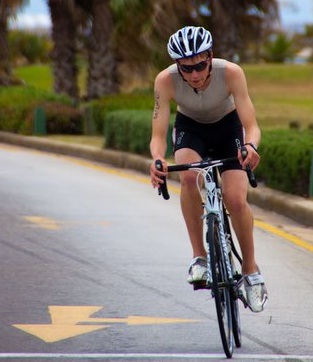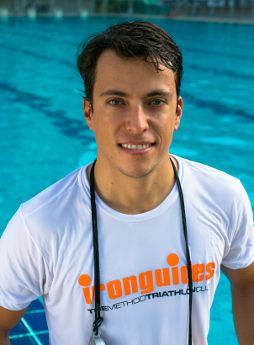Through my work with Metasport, I have had the pleasure with meeting and working with a young man from the rural Sri Lankan village of Hikkadia, His name is Lakruwan Wijesiri or ‘Lucky’ for short.
He has been able to come to Singapore on several training and racing stints through an NGO called the Foundation of Goodness. They reach out to aspiring athletes in rural communities in Sri Lanka in need of a helping hand. Lucky came to their attention after his home was washed away in the 2004 Tsunami. He was 13 at the time. Largely through his own effort working with random groups in Sri Lanka, Lucky has won the Sri Lanka Triathlon Nationals 4 years in a row. He’s now also employed full time by the Navy and they give him an allowance to train.
He used to train a lot on his own but without any real guidance. When I met him, he was keen to raise his game and start racing at regional ITU cup level. I was utterly inspired by his journey of belief, perseverance and single mindedness and was very happy to start working with him. His simple and humble approach to life has reminded me to get back to basics, especially when challenged with ‘keeping it all together’ in busy Singapore.
When I think of Lucky chasing his dreams it inspires me to stay hungry and do the same. Thank you for your friendship Lucky!
Won his 1st race on this bike:

Check out the Aerobars!
New tools from MetaSport Members : )
Working hard at home:
1st ITU Race – Singapore Triathlon 2014
Here is an article the SwimBikeRun did on him a few months ago. Click to enlarge.











 Coach Shem:
Coach Shem:  Coach Vinnie:
Coach Vinnie:  Coach Woody on his athlete, Stefan and his road to Kona with a busy work schedule and young family. Stefan also shares his history and thoughts on training with Kona as his goal.
Coach Woody on his athlete, Stefan and his road to Kona with a busy work schedule and young family. Stefan also shares his history and thoughts on training with Kona as his goal.



 I joined ironguides in late 2009 after I completed my first year as a pro. I had just moved to Switzerland then and started to work 4-5 hours a day, which let me pay my triathlon expenses. It was great to start working with my coach, as he could plan my training according to my work schedule, and he increased the quality of my training a lot, though I spent less time on my bike or running. Thanks to my swimming backgound, I never had a problem to get out the water with the first pack, but thanks to ironguides my bike splits improved a lot, and I was able to stay in the lead group during the whole bike leg and I was able to start the running in a fresher condition! This consistent work was not easy, but all was worth it as I claimed my first ever Ironman title in 2011 in Korea, and have become a steady Top-10 finisher in any Ironman or Ironman 70.3 races around the world.”
I joined ironguides in late 2009 after I completed my first year as a pro. I had just moved to Switzerland then and started to work 4-5 hours a day, which let me pay my triathlon expenses. It was great to start working with my coach, as he could plan my training according to my work schedule, and he increased the quality of my training a lot, though I spent less time on my bike or running. Thanks to my swimming backgound, I never had a problem to get out the water with the first pack, but thanks to ironguides my bike splits improved a lot, and I was able to stay in the lead group during the whole bike leg and I was able to start the running in a fresher condition! This consistent work was not easy, but all was worth it as I claimed my first ever Ironman title in 2011 in Korea, and have become a steady Top-10 finisher in any Ironman or Ironman 70.3 races around the world.” “The 12-week plan is fantastic. I have made breakthroughs in all three disciplines, especially the swim — and I am not a beginner in the sport! … for so many seasons I was sucked into the Zone-based myth and was always overtrained when I hit the Build phases. Now, even though the program is demanding, I always feel rested. I have not had an injury nor felt weak or sick. My times are always improving and there are actually LESS rest days than the Zone-based training program. It’s amazing really!” Thyrio, ironguides Forum
“The 12-week plan is fantastic. I have made breakthroughs in all three disciplines, especially the swim — and I am not a beginner in the sport! … for so many seasons I was sucked into the Zone-based myth and was always overtrained when I hit the Build phases. Now, even though the program is demanding, I always feel rested. I have not had an injury nor felt weak or sick. My times are always improving and there are actually LESS rest days than the Zone-based training program. It’s amazing really!” Thyrio, ironguides Forum  Keegan Scott “I’ve always been self-coached but didn’t want the commitment of a coach while I was interested in following a structure that works. The subscription service is a great idea as I’m still able to train using The Method, while it fits my budget and gives me flexibility to change the focus from single discipline to the balanced programme as I progress into the season.”
Keegan Scott “I’ve always been self-coached but didn’t want the commitment of a coach while I was interested in following a structure that works. The subscription service is a great idea as I’m still able to train using The Method, while it fits my budget and gives me flexibility to change the focus from single discipline to the balanced programme as I progress into the season.”










Recent Comments